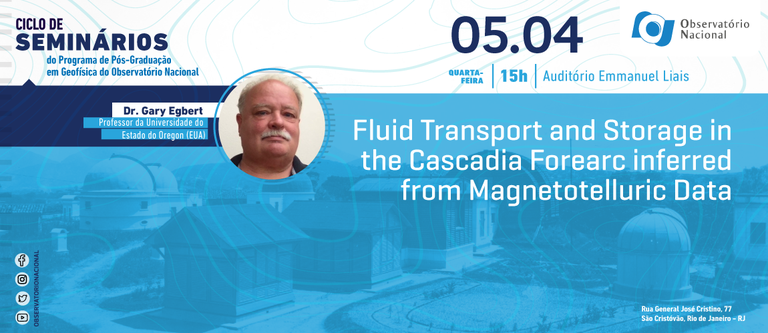Notícias
Seminário da Geofísica do ON aborda, o transporte e armazenamento de fluidos a partir de dados magnetotelúricos

Na próxima quarta-feira, dia 05 de abril, o Programa de Pós-Graduação em Geofísica do Observatório Nacional (PPGG/ON) realizará uma nova edição de seu Ciclo de Seminários.
O tema do evento, que acontecerá às 15h (horário de Brasília) de forma híbrida com transmissão pelo canal do ON no YouTube e com palestra presencial no auditório Emmanuel Liais, no campus do ON, em São Cristóvão (RJ), será “Fluid Transport and Storage in the Cascadia Forearc inferred from Magnetotelluric Data”. Para falar sobre o assunto, foi convidado o palestrante e professor da Universidade do Estado do Oregon (EUA), Dr. Gary Egbert.
Gary Egbert é professor da Universidade do Estado do Oregon (EUA) com graduação em Matemática, Mestrado em Estatística e Doutorado em Geofísica. Durante seus 35 anos de carreira como pesquisador, ele trabalhou com estatística multivariada, modelamento numérico e problemas inversos em duas grandes frentes: Eletromagnetismo e Oceanografia Física. Motivado por uma gama de problemas reais, da condutividade elétrica da Terra até correntes oceânicas, ele desenvolveu métodos de inversão 3D e de assimilação de dados para diversas aplicações geofísicas.
Título da palestra: Fluid Transport and Storage in the Cascadia Forearc inferred from Magnetotelluric Data
Resumo: Subduction of hydrated oceanic lithosphere can carry water deep into the Earth, with consequences for a range of tectonic and magmatic processes. Most of the fluid is released in the forearc where it plays a critical role in controlling the mechanical properties and seismic behaviour of the subduction megathrust. Here we present results from three-dimensional inversions of data from nearly 400 long-period magnetotelluric sites, including 64 offshore, to provide insights into the distribution of fluids in the forearc of the Cascadia subduction zone. We constrain the geometry of the electrically resistive Siletz terrane, a thickened section of oceanic crust accreted to North America in the Eocene, and the conductive accretionary complex underthrust along the margin. We find that fluids accumulate over timescales exceeding 1 My above the plate in metasedimentary units, while the mafic rocks of Siletzia remain dry. Fluid concentrations tend to peak at slab depths of 17.5 and 30 km, suggesting control by metamorphic processes, but also concentrate around the edges of Siletzia, suggesting that this mafic block is impermeable, with dehydration fluids escaping up-dip along the megathrust. Our results demonstrate that the lithology of the overriding crust can play a critical role in controlling fluid transport in a subduction zone.
Link para live no YouTube: https://www.youtube.com/watch?v=lATrL-zchLU